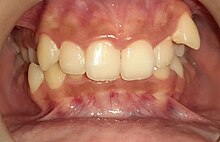| Overbite | |
|---|---|
| Specialty | Orthodontics |

Overbite is the extent of vertical (superior-inferior) overlap of the maxillary central incisors over the mandibular central incisors, measured relative to the incisal ridges.
The term overbite does not refer to a specific condition, nor is it a form of malocclusion. Rather an absent or excess overbite would be a malocclusion. Normal overbite is not measured in exact terms, but as a proportion (approximately 30–50% of the height of the mandibular incisors) and is commonly expressed as a percentage.
Other terms confused with "overbite"

Overbite is often confused with overjet, which is the distance between the maxillary anterior teeth and the mandibular anterior teeth in the anterior-posterior axis.
"Overbite" may also be used commonly to refer to Class II malocclusion or retrognathia, though this usage can be considered incorrect. This is where the mesiobuccal cusp of the maxillary first molar is situated anterior to the buccal groove of the mandibular first molar; in other words, the mandible (lower jaw) appears too far behind the maxilla. A person presenting with Class II malocclusion may exhibit excessive overbite as well, or may have the opposite problem, which is referred to as openbite (or apertognathia). In the case of apertognathia, and the teeth do not overlap enough or at all—the upper teeth protrude past the lower teeth. An open bite is a condition where the upper and lower teeth do not meet or bite in the correct position. Unlike an overbite or underbite, there is no overlapping of teeth, giving an impression of the teeth appearing “open”. A mild case of open bite can be treated with Invisalign, a popular orthodontic treatment using clear aligners. Orthodontists often recommend Invisalign to correct mild forms of open bites. However, severe open bite cases may require alternative treatments, such as surgery or other orthodontic methods.
Changing human dentition
American anthropologist C. Loring Brace has brought forth a theory that the human overbite of Europeans is only about 250 years old and was the result of the widespread adoption of the table knife and fork. Before the use of cutlery, Europeans would often clamp their teeth on a piece of meat and cut off a piece with a knife. When Europeans started using forks and knives, the cutting was done on the plate and the overbite became much more common. Brace also researched the Chinese, who had adopted chopsticks 900 years earlier and found the instances of overbites increased about the same time the new eating method was introduced. Others further speculate labiodental consonant sounds in human speech were predicated on the development of the overbite.
References
- Okeson, J.P. (2008) Management of Temporomandibular Disorders and Occlusion. Sixth Edition.
- "Overbite" at Dorland's Medical Dictionary
- Twilley, Nicola. "Freedom from food". Aeon Media Ltd. Retrieved 2014-10-06.
- Moran, Steven; Bickel, Balthasar (14 March 2019). "Softer, processed foods changed the way ancient humans spoke". The Conversation. Retrieved 20 March 2019.
External links
| Classification | D |
|---|
| Dental disease involving the jaw | |
|---|---|
| General | |
| Size | |
| Maxilla and Mandible | |
| Other |
|